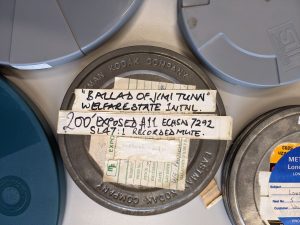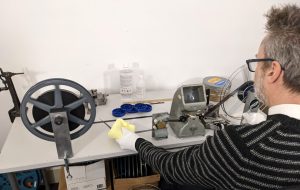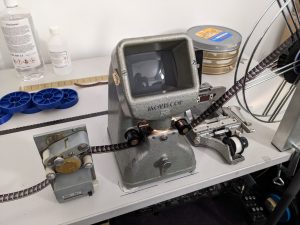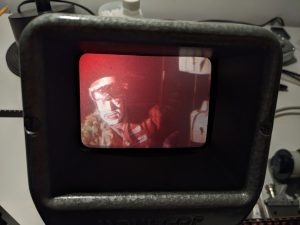In 2021, the Theatre Collection successfully applied for a Research Resources Award from the Wellcome Trust for the ‘Firestarters’ project to make available the archive of the arts organisation, Welfare State International (WSI). The project was developed in response to demand to explore WSI’s innovative methodologies from a broad spectrum of researchers and practitioners and the archive will provide evidence and inspiration for future research and practice.
Founded in 1968 by John Fox and Sue Gill, Roger Coleman and others, WSI was a loose association of freelance artists brought together by shared values and philosophy. WSI evolved from radical travelling performers to become embedded community artists and celebrants, working to weave art more fully into the fabric of life. Under the Welfare State umbrella, a remarkable group of engineers, musicians, sculptors, performers, poets and pyrotechnicians invented and developed site-specific theatre in landscape, lantern processions, spectacular fireshows, community carnivals and participatory festivals. The scale of the archive means that the project will take over three years to complete. A comprehensive archive catalogue will be published online, key material will be digitised for preservation and access, and conservation work will ensure the long-term survival of this important collection.
The ‘Firestarters’ project to catalogue and make accessible the archive of the arts organisation, Welfare State International (WSI) is now underway, so we thought we’d share a project update and highlight some of the work we’ve done so far. This first part of the project has focussed on establishing physical and intellectual control of the collection as well as safeguarding the long-term viability of the AV material through conservation and digitisation.
Cataloguing
As Project Archivist, I’ve undertaken background research and produced a full production list of more than 400 performances, events and projects for the period Welfare State International were operational to assist with the sorting process. The first sort of 245 boxes has been completed and the second, more detailed, sort is underway with all performance-related material from the original accession now sorted by production. I assigned temporary reference numbers to all the AV material enabling digitisation to begin.

AV digitisation
Since December 2022, Nigel Bryant, AV Digitisation Officer has digitised 146 magnetic and optical media items across 17 different formats including U-matic, VHS, Betacam, Hi8, Video 8, CD audio and DVD. Both preservation archival quality copies and viewing copies have been produced. Digital copies of duplicate material have been identified and discarded and summary content descriptions of all digitised AV have been recorded. Essential servicing of AV equipment also took place across several formats to ensure optimum quality of digital copies was maintained.
Video highlights have included a copy of the Barrow community film ‘King Real & The Hoodlums’ (1984) from 1” video tape, so very good quality. The film was made for TV and involved 150 local people; script by Adrian Mitchell based on King Lear. In addition to the film, there is also a recording of ‘King Real – making of’ feature from BBC Newsnight, which includes interviews with cast members from the local community. This year is the 40th anniversary of the making of ‘King Real’, an occasion which has been marked by some of those involved in the film from WSI and the local community with a celebratory singalong in Barrow.
There are also recordings of other TV programmes featuring the work of WSI including the BBC2 programme Open Space with footage of ‘A Midsummer Night’s Belfast’ from a community residency in Belfast, June 1983, and the Thames TV programme Afternoon Plus featuring preparations for ‘Parliament in Flames’, interviews with WSI members, as well as audience reactions to the large-scale spectacle. In addition to recordings of performances, there is extensive coverage of Ulverston Lantern Processions from the 1980s-1990s.
Footage of international projects includes rushes and an edit of a WSI performance ‘The Wasteland and the Wagtail’, a special commission for the 1st International Theatre Festival in Toga Village, Japan from July 1982, a complete set of high quality rushes from ‘False Creek: A Visual Symphony’ from World Expo ‘86, in Vancouver, Canada, footage of a performance of ‘The Dead Carpenter’ at Rotterdamse Kunststichting, The Netherlands in 1976, and rushes and edit of ‘Tempest on Snake Island’ for the Toronto Theatre Festival in May 1981.
Manual Film Inspections
In preparation for creating access copies for the cine film within the collection, Nigel and I have undertaken manual film inspections for all 152 16mm films, in addition to 7 Super 8mm films. Before undertaking manual film inspections, I tested all the film for acetate film base degradation (vinegar syndrome), using A-D strips. The small A-D strips are placed in the can and left for a specified amount of time depending on the storage conditions; the strips change colour to indicate the level of deterioration.
Manually inspecting each film is essential, so an assessment can be made about whether the film would be safe to run on a Steenbeck (flatbed film editing machine) to create access copies. The inspection included identifying the film type and any edge codes to date the film, as well as measuring the film and core diameter to ensure appropriate storage. A section of film was measured and compared to stock film to assess whether the storage conditions over the years had caused the film to stretch or shrink.
As the image below shows, the film was then manually wound onto a core, through a duration counter and viewer, so the film could be viewed, notes about the content recorded, and an estimated duration taken. The film was also lightly cleaned during this process. With manual film inspections, although possible to view the moving images, it is not possible to listen to any sound recordings, which makes the content more difficult to identify.


The majority of the films within the collection were stored on 2” cores or projection reels, so during the inspections all the films were wound onto the larger 3” cores for optimum storage. Each film was assessed for physical damage including scratches, perforation damage, mould, dirt and oil, warpage and colour fading. Splices were also inspected and repaired or reinforced where required.
Within the collection there are a few 8mm and 35mm films, which will be inspected once additional equipment can be sourced. As can be the case with older formats, the equipment required to play or view them is often scarce and therefore can be expensive.
There’s been some great footage on the 16mm film, including some projects filmed for TV, one for the arts programme Aquarius with footage from a 3 week residency in Burnley in 1975 including the final show featuring a large procession and ice sculpture, a 1982 performance of ‘Doomsday Fair’ and an early performance from 1973 made in Rotterdam.

There is also some footage of a naming ceremony on Bodmin Moor from the early 1970s and the South West tour of ‘The Travels of Lancelot Quail’ from 1972, which was one month of processional theatre from Glastonbury through Somerset, Devon and Cornwall. The footage includes the finale of the performance, as the group of performers climb aboard a boat on the beach at Marazion and head out to sea and board a submarine. It’s been brilliant to see moving images of performances, having only seen a few photographic images whilst sorting the documentation.
We look forward to posting more project updates as we go!
Siân Williams, Project Archivist

As the individual who invited WSI to make their base in Burnley, I can attest to it being for longer than a few weeks – more like several years, with (OK not huge) financial support for gigs and celebrations.